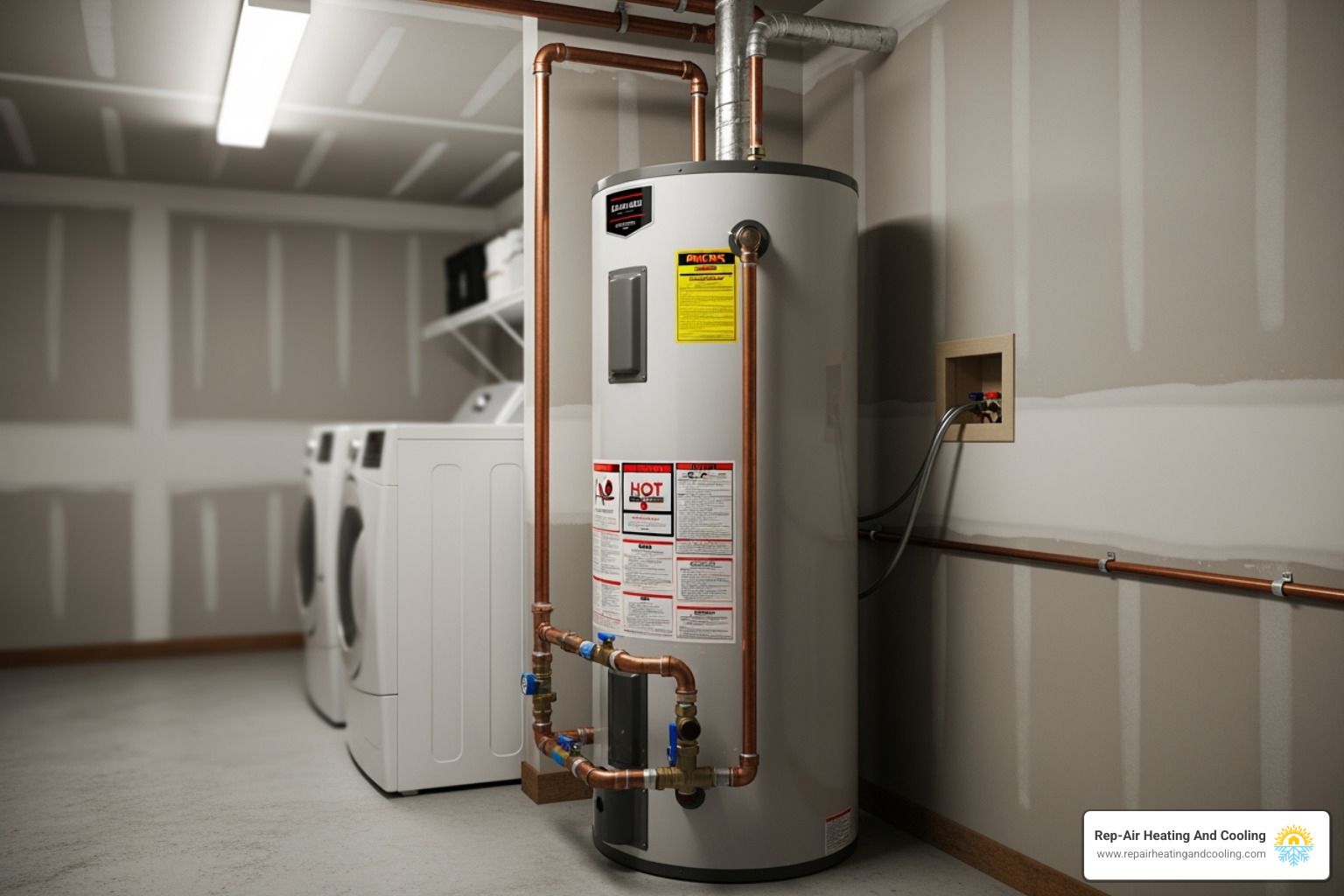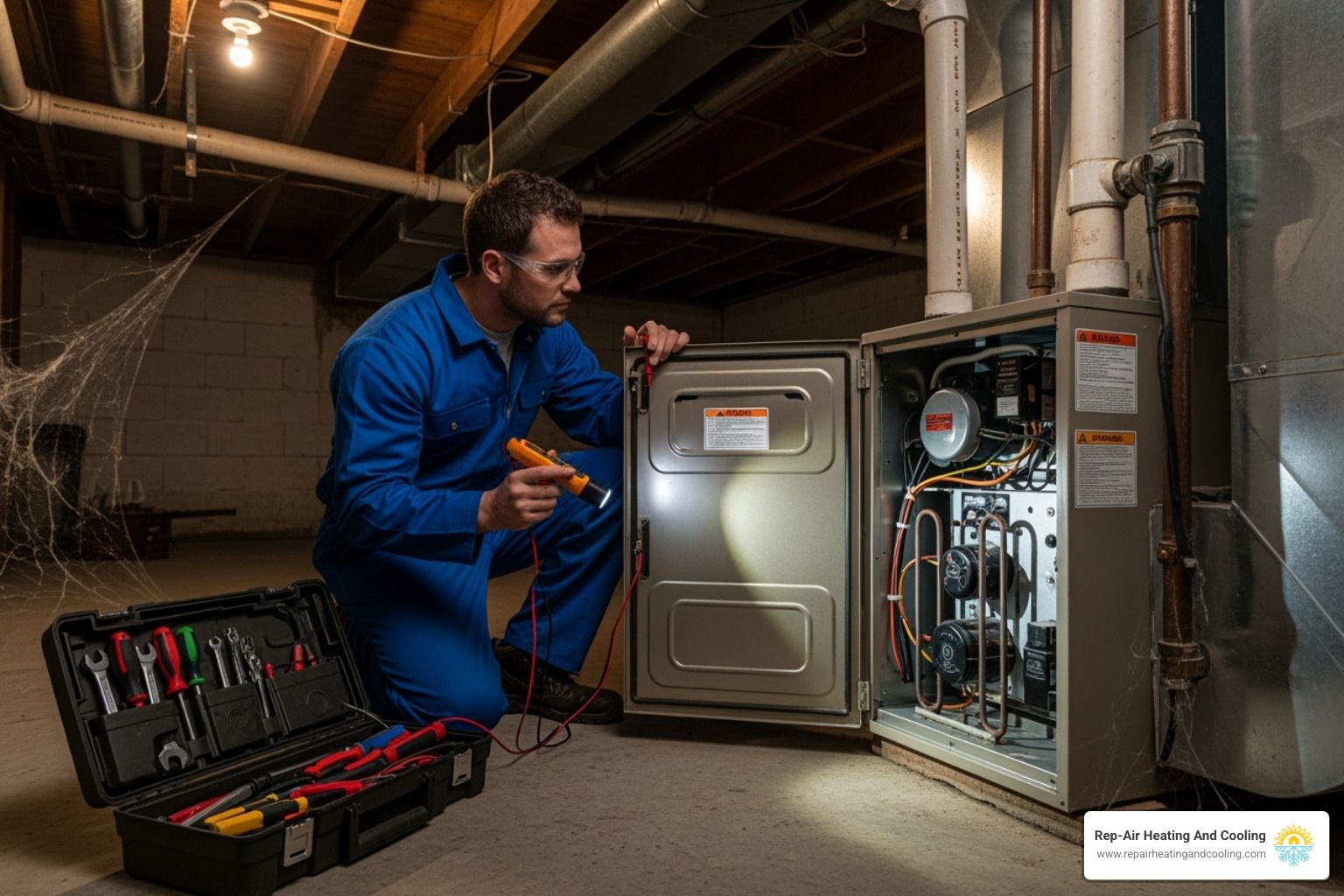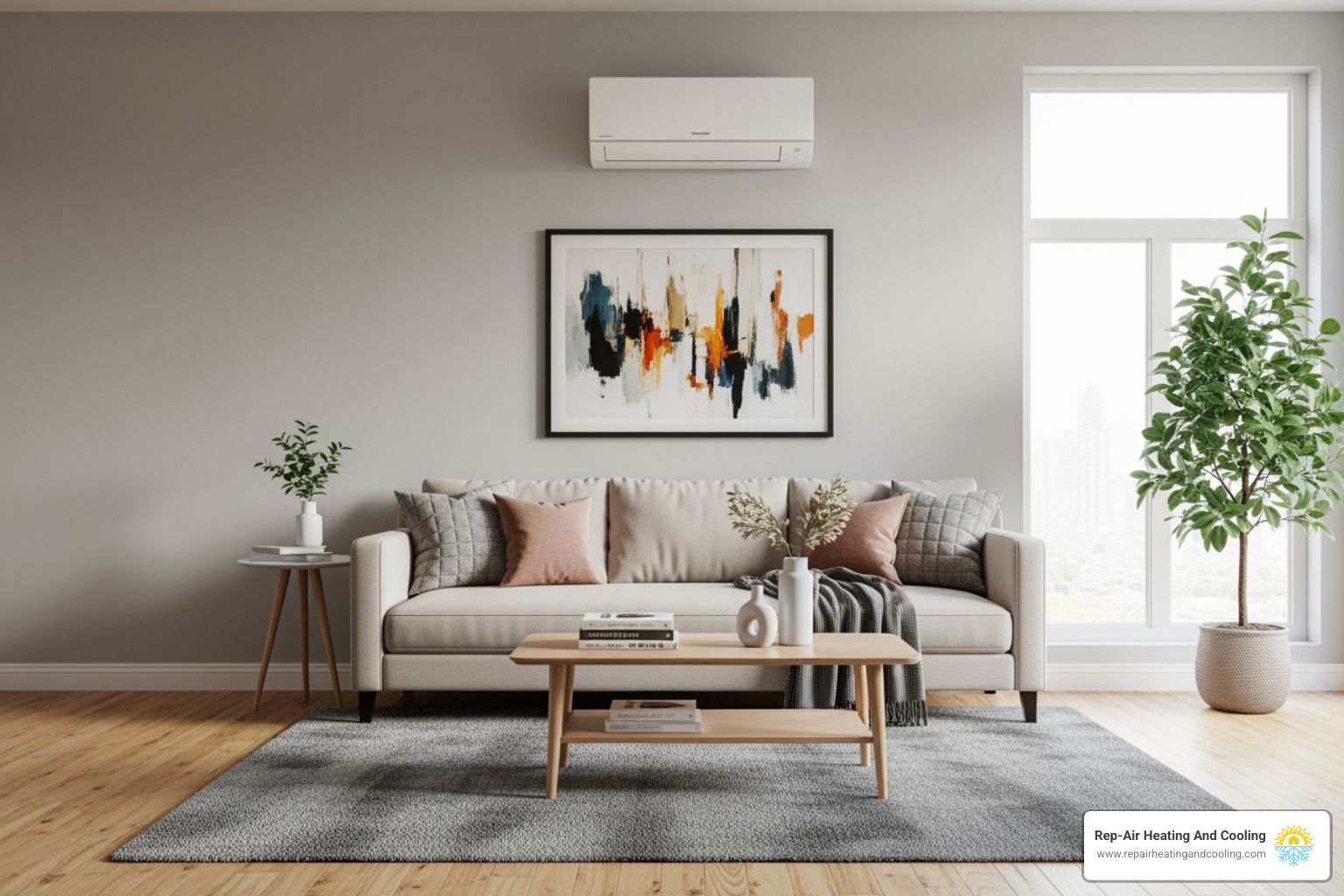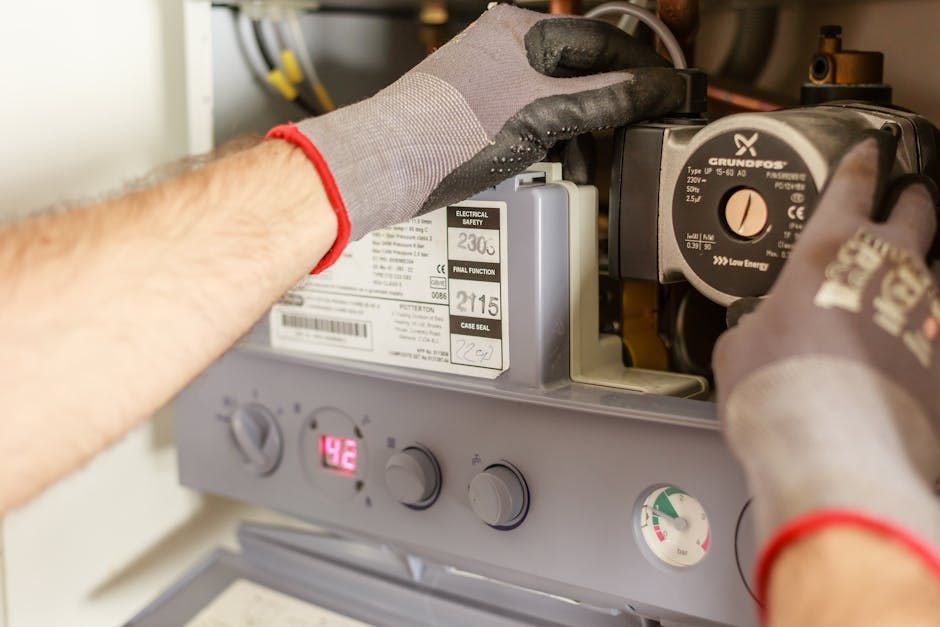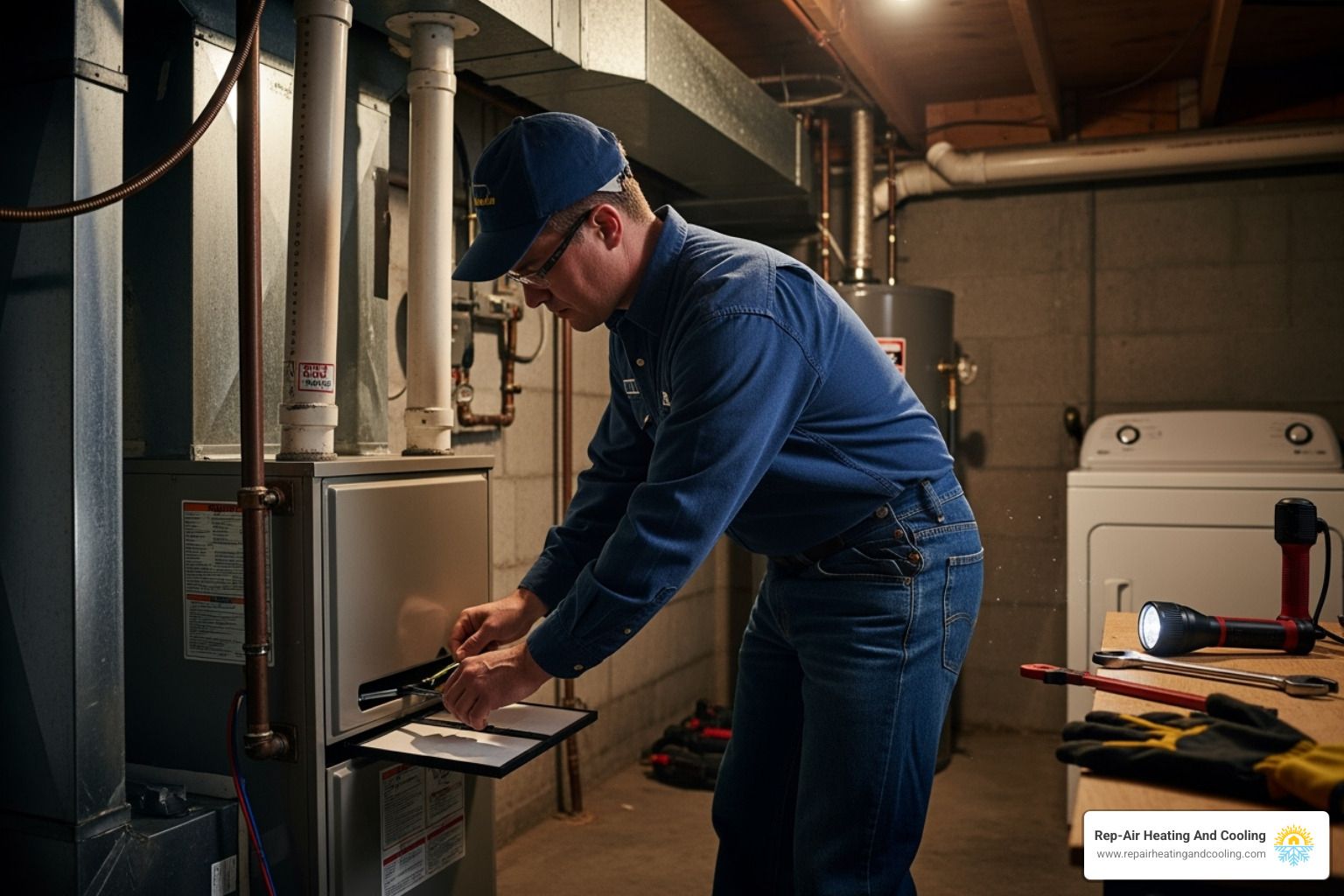The Goldilocks Guide to Water Heater Sizing: Not Too Big, Not Too Small
IMPORTANT NOTE: . Our company is located in British Columbia, Canada. If you are reading this article in another location, we hope you enjoy the information, but unfortunately we cannot service you.

Table of Contents
ToggleWhy Getting Water Heater Sizing Right Is Critical for Your Home
Water heater sizing is the process of determining the correct capacity and output for your home’s hot water needs. Just like Goldilocks found the perfect porridge, your water heater needs to be sized “just right” – not too big, not too small.
Quick Water Heater Sizing Guide:
- Tank water heaters: Based on gallon capacity and First Hour Rating (FHR)
- 1-2 people: 30-40 gallons
- 3-4 people: 50-75 gallons
- 5+ people: 75-100 gallons
- Tankless water heaters: Based on flow rate (GPM) and temperature rise
- 1-2 fixtures: 3.5 GPM
- 2-3 fixtures: 5 GPM
- 3-4 fixtures: 7 GPM
- Key factors: Household size, peak usage times, number of bathrooms, appliance demands
Getting the size wrong creates real problems. Too small means running out of hot water during your morning shower or when the dishwasher kicks in. Too big means you’re heating water you’ll never use, wasting energy and money every month.
A properly sized water heater operates more efficiently and meets your household’s hot water needs without waste. The research shows that water heaters are the second-largest energy consumer in most homes, making correct sizing essential for both comfort and your utility bills.
In the Lower Mainland, where groundwater temperatures average around 50°F year-round, sizing becomes even more important. Your water heater works harder in our climate, making efficiency crucial.
Key Factors That Determine Your Perfect Water Heater Size
Proper water heater sizing goes beyond just counting people in your home; it’s about understanding your family’s unique lifestyle. Your household size is the starting point, but your daily routines determine the real demand. Key factors include:
- Household Size & Habits: A family of four that showers at different times has different needs than one where everyone gets ready at 7 AM. Your daily routines are critical.
- Number of Bathrooms & Fixtures: More bathrooms mean higher potential demand. A large soaker tub, for instance, requires significantly more capacity than a standard one.
- High-Demand Appliances: Dishwashers and clothes washers (especially on hot cycles) are major hot water consumers that must be factored into your total needs.
- Climate Impact: In the Lower Mainland, our cold groundwater is a crucial factor. With an average temperature of 50°F, your heater must work hard to achieve a 70°F temperature rise for a 120°F shower. This makes correct sizing even more important. You can use this map to find your local groundwater temperature to see your specific conditions.
Sometimes water quality itself can affect performance. You can find more info about improving your home’s water quality here.
Understanding Your Peak Hour Demand
Your peak hour demand is the single busiest hour for hot water use in your home, usually during morning or evening routines. Sizing for this “hot water rush hour” is the key to ensuring you never run out. If your heater can handle the morning chaos of a shower, the dishwasher, and a sink all running at once, it can handle anything.
To calculate your household’s peak demand, add up the typical usage for activities that happen simultaneously:
- Shower: 10-15 gallons (for 5 minutes)
- Tub bath: 15-25 gallons
- Dishwasher load: 5-10 gallons
- Clothes washer load: 25-40 gallons
- Hand washing/shaving: 2-4 gallons
- Food preparation: 3-6 gallons
For example, a peak hour with one 10-minute shower (30 gallons), hand washing (5 gallons), and a dishwasher running (8 gallons) equals a 43-gallon demand. Your water heater must be able to meet this.
How Family Size and Habits Influence Sizing
While a starting point, family size is just one piece of the puzzle. 1-2 people can often use a 30-40 gallon tank, as there’s more recovery time between uses. A family of 4, however, typically needs a 50-75 gallon tank to handle simultaneous use.
It’s also vital to consider future needs. Are you planning to expand your family, or will your kids soon become teenagers who take longer showers? Planning for this growth can prevent you from needing to replace an undersized unit in a few years.
The difference between staggered and simultaneous use is huge. If your family spreads out hot water use, a smaller capacity might work. But if everyone needs hot water at the same time, you’ll need a larger capacity to avoid cold showers.
If this seems overwhelming, we’ve got you covered with these hot water heater basics for new homeowners.
A Tale of Two Heaters: Your Guide to Water Heater Sizing
Water heater sizing methods differ completely between traditional tank-style units and modern tankless ones. Tank heaters are sized by storage capacity, while tankless heaters are sized by flow rate and heating power.
- A tank-style water heater acts like a reservoir, keeping a supply of hot water ready. It’s sized by its gallon capacity and, more importantly, its First Hour Rating (FHR).
- A tankless water heater heats water on-demand. It’s sized by its maximum flow rate (gallons per minute, or GPM) and the temperature rise it can achieve.
Fuel type also impacts performance. Gas water heaters (natural gas or propane) heat water much faster than electric water heaters. This means a gas unit, whether tank or tankless, can handle higher demand and recover more quickly than its electric counterpart, a key consideration in the chilly Lower Mainland.
Calculating Your Needs: A Guide to Tank-Style Water Heater Sizing
For tank-style water heater sizing, the most critical number is the First Hour Rating (FHR). This rating, found on the yellow EnergyGuide label, tells you exactly how many gallons of hot water the unit can deliver in one hour, starting with a full tank.
Your goal is to match the FHR to your household’s peak hour demand. If your busiest hour requires 45 gallons of hot water, you need a water heater with an FHR of at least 45.
Tank capacity (the number of gallons the tank holds) is a starting point, but FHR is the true measure of performance. The recovery rate—how quickly the heater reheats a new supply of water—also plays a role. Gas heaters have a much faster recovery rate than electric ones, allowing a smaller gas tank to potentially outperform a larger electric one.
As a general guideline:
- 1-2 people: 30-40 gallon tank
- 2-3 people: 40-50 gallon tank
- 3-4 people: 50-60 gallon tank
- 5+ people: 60-80 gallon tank
These are just estimates; your actual peak demand is the most important factor. The U.S. Department of Energy provides more detail on Sizing a New Water Heater | Department of Energy.
On-Demand Perfection: A Guide to Tankless Water Heater Sizing
Sizing a tankless water heater focuses on two things: flow rate and temperature rise.
Flow rate, measured in gallons per minute (GPM), is the total volume of hot water the unit can produce at any given moment. To determine your need, add up the GPM of all fixtures you might use at the same time. For example:
- Shower: 2.5 GPM
- Bathroom Sink: 1.5 GPM
- Kitchen Sink: 1.5 GPM
- Dishwasher: 1.5 GPM
If you plan to run a shower (2.5 GPM) and a dishwasher (1.5 GPM) simultaneously, you’ll need a unit that can provide at least 4.0 GPM.
Temperature rise is how much the heater needs to warm the water. In the Lower Mainland, our groundwater is about 50°F. For a 120°F shower, the unit must create a 70°F temperature rise. A tankless unit’s GPM output decreases as the required temperature rise increases. Always check the product specifications for the GPM rating at the 70°F rise needed for our climate, not just its maximum advertised GPM.
Tankless systems provide endless hot water, as long as you don’t exceed their flow rate. Learn more about the 5 Benefits of Tankless Hot Water Heaters.
Common Sizing Mistakes and Special Considerations
Many common water heater sizing mistakes are easily avoidable. The two biggest pitfalls are choosing a unit that’s too small or too large.
-
The Problem with Undersizing: A unit that’s too small will constantly run out of hot water during peak times. This not only causes daily frustration but also forces the unit to overwork, leading to premature wear and tear and a shorter lifespan.
-
The Problem with Oversizing: A unit that’s too large means you’re wasting energy heating unused water 24/7. This results in higher utility bills, a greater upfront cost, and wasted space in your utility room.
Homeowners often make these mistakes by ignoring peak demand, forgetting to include appliances like dishwashers in their calculations, or not planning for future needs like a growing family.
Even a correctly sized unit can have issues. If you notice problems, our guides can help you diagnose Signs Your Water Heater Might Fail or figure out Why is My Water Heater Leaking?. An older, incorrectly sized unit is especially tough on your wallet, as explained in How an Old Water Heater Affects Energy Bills.
Sizing for Heat Pump and Solar Water Heaters
While most homes use tank or tankless heaters, heat pump and solar water heaters are efficient alternatives that require special sizing.
-
Heat Pump Water Heaters: These units transfer heat from the surrounding air into the water. They use a storage tank (typically 50-80 gallons) and are sized using the First Hour Rating (FHR). They need adequate space for air circulation and work best in areas that remain between 40°F and 90°F.
-
Solar Water Heaters: Sizing these involves calculating the required solar collector area and storage tank volume based on your family’s needs and local solar conditions. A typical rule is to have 1.5 to 2 gallons of storage for every square foot of collector area.
For both of these advanced systems, professional consultation is essential to ensure they are sized and installed correctly for optimal performance. You may be able to save on an upgrade with Heat Pump Water Heater Rebates.
Frequently Asked Questions about Water Heater Sizing
We understand that water heater sizing can feel overwhelming. After helping countless families in the Lower Mainland find their perfect hot water solution, we’ve heard just about every question you can imagine. Here are the most common concerns we address, with honest answers to help you feel confident about your decision.
What happens if my water heater is too small?
An undersized water heater is a constant source of frustration. The most obvious sign is running out of hot water during showers or when appliances are in use. This daily inconvenience is compounded by long-term problems.
An undersized unit is always working overtime to meet demand, which leads to premature wear and tear on its components. This means more frequent repairs and a shorter overall lifespan for the heater. Your mornings can become a strategic challenge to avoid using too much hot water at once.
If you’re constantly battling hot water shortages, it might be time to consider whether your current unit is showing other warning signs. Check out our guide on Signs Your Water Heater Might Fail to see if replacement is in your future.
What happens if my water heater is too big?
While you won’t run out of hot water, an oversized water heater creates its own set of costly problems. The biggest issue is wasted energy heating unused water. If your tank holds 80 gallons but your family only uses 40, you’re paying to keep that extra 40 gallons hot 24/7.
This standby heat loss translates directly into higher utility bills every month. Over the life of the water heater, this can add up to hundreds of dollars in wasted energy costs. Additionally, you face a higher upfront cost for capacity you don’t need and lose unnecessary space in your utility room.
If you’re curious about how much your current water heater might be costing you, take a look at our article on How an Old Water Heater Affects Energy Bills.
Can I use an online calculator to size my water heater?
Online calculators are a great starting point for water heater sizing. They can help you understand key concepts like GPM, temperature rise, and First Hour Rating, giving you a general idea of the size range you might need.
However, these tools have limitations. They rely on averages and can’t account for the unique factors of your home, such as:
- Your specific fixture flow rates (e.g., a high-flow rain showerhead)
- Unique family habits (e.g., teenagers who take long showers)
- Future plans like a bathroom renovation
- Local water conditions
Think of an online calculator as a helpful guide, not a final answer. Professional verification is crucial to get it right. An expert considers all the variables to ensure your water heater is sized perfectly for your family’s actual needs, not an algorithm’s best guess. This investment should serve you for 10-15 years, so it’s worth getting it right the first time.
Get Your Sizing “Just Right” with Professional Help
Finding the perfect water heater is truly about achieving that Goldilocks principle we talked about at the beginning: not too big, not too small, but just right. When you get water heater sizing correct, it’s like finding that perfect sweet spot where everything just works seamlessly.
Think about it this way – when your water heater is properly sized, you never have to think about it. You turn on the tap, hot water flows. Someone starts the dishwasher while you’re in the shower, and the water stays perfectly warm. Your utility bills reflect efficient operation rather than wasted energy. That’s the magic of accurate sizing for both comfort and efficiency.
We’ve covered a lot of ground in this guide, from understanding your peak hour demand to calculating flow rates for tankless units. But here’s the thing – while all this information is incredibly valuable, there’s something to be said for having an expert take a look at your specific situation.
The value of professional assessment goes beyond just crunching numbers from a chart. When our team visits your home, we’re looking at the big picture. We see how your plumbing system is laid out, we understand the unique challenges of Lower Mainland water conditions, and we can spot potential issues that might affect your water heater’s performance.
Maybe your home has an unusual layout where hot water has to travel a long distance to reach your master bathroom. Perhaps you have plans to renovate and add another bathroom in a few years. Or maybe your family’s hot water habits are just different from the “average” household that online calculators assume.
At Rep-Air Heating And Cooling, we’ve been helping homeowners throughout the Lower Mainland find their perfect hot water solutions for years. We understand that every family is different, and we take pride in treating you like family while we figure out exactly what will work best in your home.
Our approach isn’t about selling you the biggest or most expensive unit. It’s about finding that “just right” solution that meets your needs without waste. Whether you’re in Mission, Abbotsford, Langley, or anywhere else in our service area, we bring the same thorough, caring approach to every installation.
Expert installation is just as important as proper sizing. Even the perfectly sized water heater won’t perform as expected if it’s not installed correctly. Our team ensures everything is connected properly, tested thoroughly, and ready to provide years of reliable service.
Don’t leave your home’s hot water comfort to chance. Let us help you get your sizing “just right” from the start.
Contact us for professional water heater installation in Mission
Request your service today!
Our team of highly trained technicians are standing by ready to help you out with all of your service, repair, and installation needs. You can count on us for on-time repairs, professional installation, and the friendliest customer service in town!Contact Rep-Air Heating & Cooling today to get started with service by requesting a quote online, or by phone at (844) 218-3362.
Request Service
Contact us today to request an estimate or schedule service.





